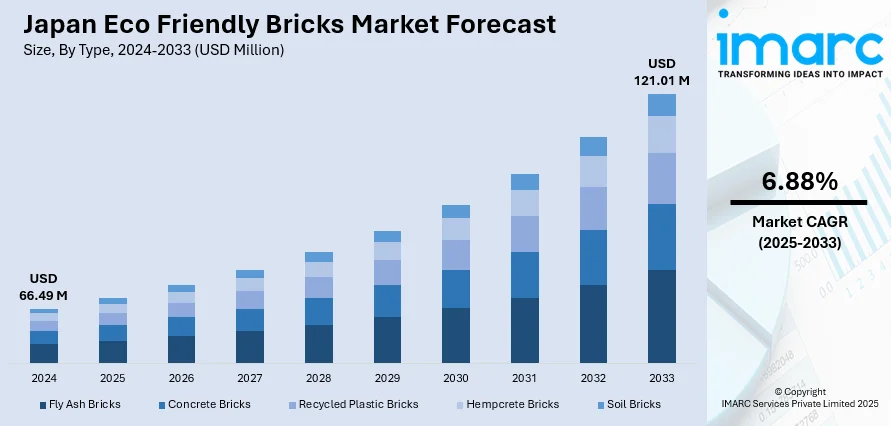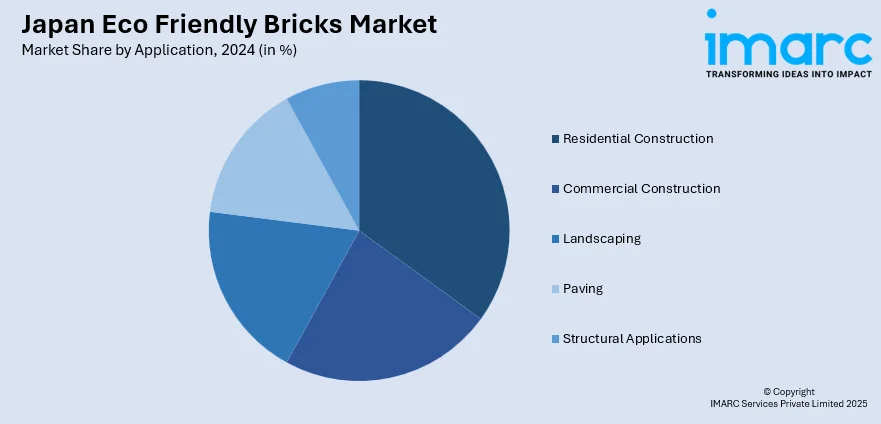
Japan Eco Friendly Bricks Market Size, Share, Trends and Forecast by Type, Application, and Region, 2025-2033
Japan Eco Friendly Bricks Market Overview:
The Japan eco friendly bricks market size reached USD 66.49 Million in 2024. Looking forward, IMARC Group expects the market to reach USD 121.01 Million by 2033, exhibiting a growth rate (CAGR) of 6.88% during 2025-2033. The market is advancing, driven by stringent environmental regulations, innovative construction technologies, and a cultural emphasis on sustainability. The adoption of green building certifications and the integration of recycled materials in brick production reflect the nation's commitment to reducing carbon emissions and enhancing energy efficiency, shaping the trajectory of the Japan eco friendly bricks market share.
|
Report Attribute
|
Key Statistics
|
|---|---|
|
Base Year
|
2024 |
|
Forecast Years
|
2025-2033
|
|
Historical Years
|
2019-2024
|
| Market Size in 2024 | USD 66.49 Million |
| Market Forecast in 2033 | USD 121.01 Million |
| Market Growth Rate 2025-2033 | 6.88% |
Japan Eco Friendly Bricks Market Trends:
Technological Advancements and Material Innovation
Technological innovation is a key driver of the eco-friendly bricks market in Japan. New brick-making techniques now integrate recycled materials like fly ash, slag, and industrial waste, reducing dependency on natural clay and cutting carbon emissions. Manufacturers are adopting cleaner production technologies, such as low-temperature kilns, which consume less energy. Research institutions in Japan are also developing alternatives to traditional cement using biodegradable and carbon-sequestering materials. These advances not only improve sustainability but also enhance product performance, such as thermal insulation and durability, which are crucial in disaster-prone regions. As Japan moves toward a circular economy and net-zero emissions goals, continuous innovation in eco-brick materials and manufacturing processes is essential. These innovations are making eco-friendly bricks both cost-effective and environmentally viable in the construction sector.

Rising Consumer Awareness and Demand for Sustainable Housing
Consumer preferences in Japan are increasingly shifting toward sustainable living, significantly boosting the Japan eco friendly bricks market growth. Homebuyers and developers alike are showing strong interest in energy-efficient, low-impact construction. Public concern over climate change and natural disasters has heightened awareness of building materials that offer resilience, reduced emissions, and improved energy performance. Government-promoted initiatives like Zero Energy Houses (ZEH) further amplify this trend by encouraging builders to use materials that minimize energy consumption. Eco-friendly bricks, which offer superior insulation and are often made with recycled content, align well with these consumer expectations. As environmental consciousness grows, more residential and commercial projects are opting for green alternatives. This rising awareness and lifestyle shift continue to create sustained demand for eco-bricks across Japan’s urban and suburban housing markets.
Urban Growth and Sustainable Infrastructure Demand
Japan’s ongoing urban development and infrastructure renewal are pushing the construction industry to adopt more sustainable materials, including eco-friendly bricks. With population concentration in urban centers and frequent natural disasters, there's a growing emphasis on building resilient and energy-efficient infrastructure. Government-led initiatives like smart city developments and low-carbon urban planning projects incorporate sustainability benchmarks, often mandating the use of green materials. The Tokyo Bay eSG Project, for instance, integrates environmental restoration and energy efficiency into large-scale urban redevelopment. Eco-friendly bricks, offering thermal efficiency and reduced carbon output, are ideally suited for such projects. As city planners and developers align with national climate goals, the use of sustainable building blocks is becoming a standard. This trend supports long-term growth in Japan’s eco-friendly bricks market.
Japan Eco Friendly Bricks Market Segmentation:
IMARC Group provides an analysis of the key trends in each segment of the market, along with forecasts at the country and regional levels for 2025-2033. Our report has categorized the market based on type and application.
Type Insights:
- Fly Ash Bricks
- Concrete Bricks
- Recycled Plastic Bricks
- Hempcrete Bricks
- Soil Bricks
The report has provided a detailed breakup and analysis of the market based on the type. This includes fly ash bricks, concrete bricks, recycled plastic bricks, hempcrete bricks, and soil bricks.
Application Insights:

- Residential Construction
- Commercial Construction
- Landscaping
- Paving
- Structural Applications
A detailed breakup and analysis of the market based on the application have also been provided in the report. This includes residential construction, commercial construction, landscaping, paving, and structural applications.
Regional Insights:
- Kanto Region
- Kansai/Kinki Region
- Central/ Chubu Region
- Kyushu-Okinawa Region
- Tohoku Region
- Chugoku Region
- Hokkaido Region
- Shikoku Region
The report has also provided a comprehensive analysis of all the major regional markets, which include the Kanto Region, Kansai/Kinki Region, Central/ Chubu Region, Kyushu-Okinawa Region, Tohoku Region, Chugoku Region, Hokkaido Region, and Shikoku Region.
Competitive Landscape:
The market research report has also provided a comprehensive analysis of the competitive landscape. Competitive analysis such as market structure, key player positioning, top winning strategies, competitive dashboard, and company evaluation quadrant has been covered in the report. Also, detailed profiles of all major companies have been provided.
Japan Eco Friendly Bricks Market Report Coverage:
| Report Features | Details |
|---|---|
| Base Year of the Analysis | 2024 |
| Historical Period | 2019-2024 |
| Forecast Period | 2025-2033 |
| Units | Million USD |
| Scope of the Report |
Exploration of Historical Trends and Market Outlook, Industry Catalysts and Challenges, Segment-Wise Historical and Future Market Assessment:
|
| Types Covered | Fly Ash Bricks, Concrete Bricks, Recycled Plastic Bricks, Hempcrete Bricks, Soil Bricks |
| Applications Covered | Residential Construction, Commercial Construction, Landscaping, Paving, Structural Applications |
| Regions Covered | Kanto Region, Kansai/Kinki Region, Central/ Chubu Region, Kyushu-Okinawa Region, Tohoku Region, Chugoku Region, Hokkaido Region, Shikoku Region |
| Customization Scope | 10% Free Customization |
| Post-Sale Analyst Support | 10-12 Weeks |
| Delivery Format | PDF and Excel through Email (We can also provide the editable version of the report in PPT/Word format on special request) |
Key Questions Answered in This Report:
- How has the Japan eco friendly bricks market performed so far and how will it perform in the coming years?
- What is the breakup of the Japan eco friendly bricks market on the basis of type?
- What is the breakup of the Japan eco friendly bricks market on the basis of application?
- What is the breakup of the Japan eco friendly bricks market on the basis of region?
- What are the various stages in the value chain of the Japan eco friendly bricks market?
- What are the key driving factors and challenges in the Japan eco friendly bricks market?
- What is the structure of the Japan eco friendly bricks market and who are the key players?
- What is the degree of competition in the Japan eco friendly bricks market?
Key Benefits for Stakeholders:
- IMARC’s industry report offers a comprehensive quantitative analysis of various market segments, historical and current market trends, market forecasts, and dynamics of the Japan eco friendly bricks market from 2019-2033.
- The research report provides the latest information on the market drivers, challenges, and opportunities in the Japan eco friendly bricks market.
- Porter's five forces analysis assist stakeholders in assessing the impact of new entrants, competitive rivalry, supplier power, buyer power, and the threat of substitution. It helps stakeholders to analyze the level of competition within the Japan eco friendly bricks industry and its attractiveness.
- Competitive landscape allows stakeholders to understand their competitive environment and provides an insight into the current positions of key players in the market.
Need more help?
- Speak to our experienced analysts for insights on the current market scenarios.
- Include additional segments and countries to customize the report as per your requirement.
- Gain an unparalleled competitive advantage in your domain by understanding how to utilize the report and positively impacting your operations and revenue.
- For further assistance, please connect with our analysts.
 Request Customization
Request Customization
 Speak to an Analyst
Speak to an Analyst
 Request Brochure
Request Brochure
 Inquire Before Buying
Inquire Before Buying




.webp)




.webp)












